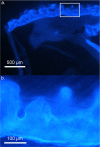Intense bone fluorescence reveals hidden patterns in pumpkin toadlets
- PMID: 30926879
- PMCID: PMC6441030
- DOI: 10.1038/s41598-019-41959-8
Intense bone fluorescence reveals hidden patterns in pumpkin toadlets
Abstract
The phenomenon of fluorescence can be used by animals to change effective colouration or patterning, potentially to serve functions including intra- and interspecific signalling. Initially believed to be restricted to marine animals, fluorescent colours are now being described in an increasing number of terrestrial species. Here, we describe unique, highly fluorescent patterns in two species of pumpkin toadlets (Brachycephalus ephippium and B. pitanga). We establish that the origin of the fluorescence lies in the dermal bone of the head and back, visible through a particularly thin skin. By comparing them to those of the closely related species Ischnocnema parva, we demonstrate that pumpkin toadlets' bones are exceptionally fluorescent. We characterize the luminescence properties of the toadlets' bones and discuss the potential function of fluorescent patterns in natural lighting conditions.
Conflict of interest statement
The authors declare no competing interests.
Figures





References
Publication types
MeSH terms
LinkOut - more resources
Full Text Sources

